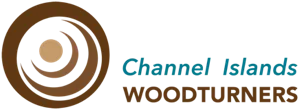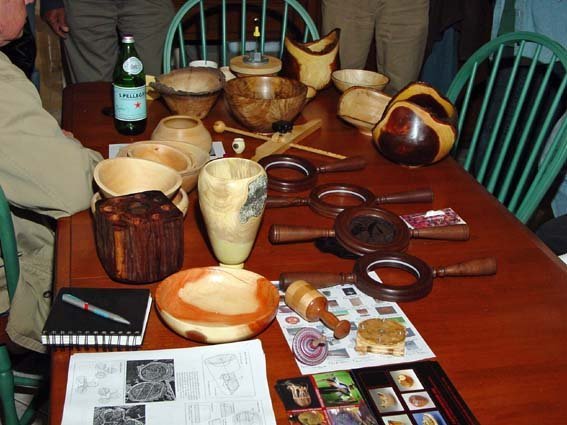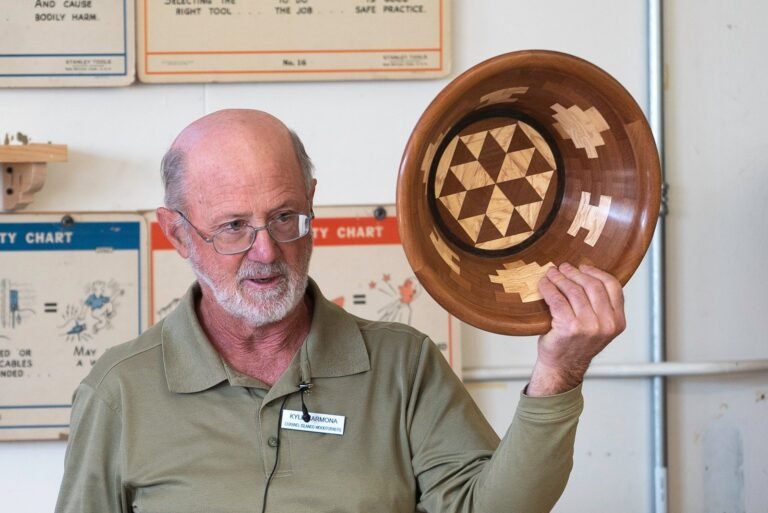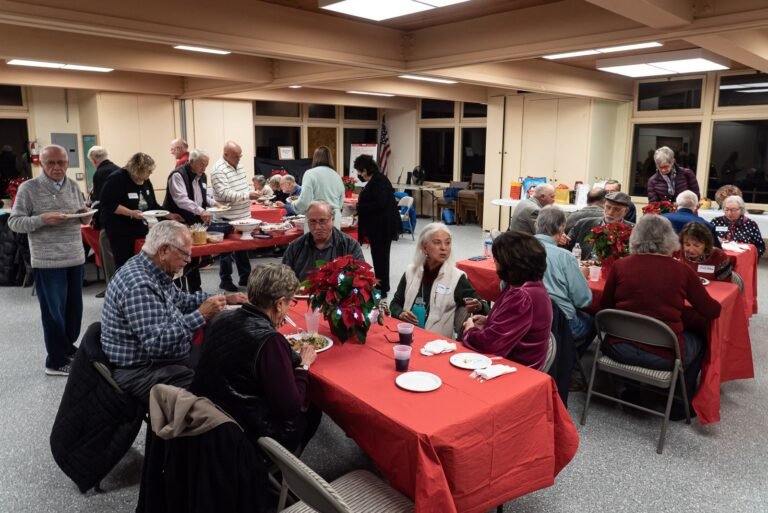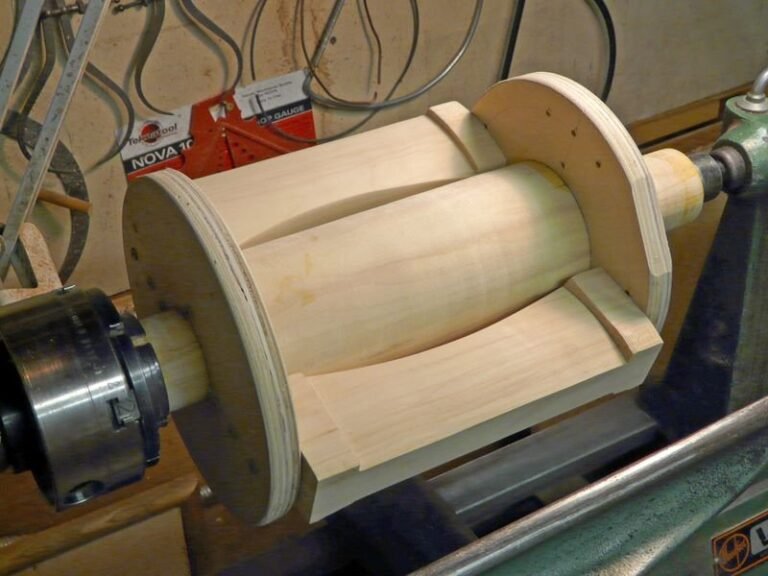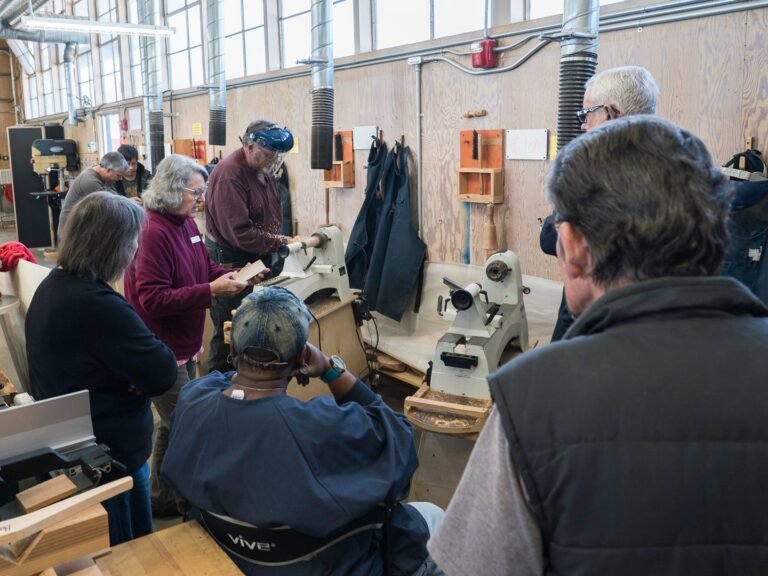April, 2004
Meeting Information: Saturday, April 24 from 9:00 am to Noon
Russ Babbitt: Making Lidded Boxes
At Levi Mize Woodcraftsman’s Shop
162 Aviador Street #17+18, Camarillo, CA 93010
NOTE THIS IS A NEW LOCATION
BRING YOUR OWN CHAIR OR SIT ON THE FLOOR
The Club will be holding many of our meetings here thanks to Levi. This will give us the additional space we need for everyone to attend the demonstrations. The overhead mirror, and when needed the TV monitor system will be in place. Aviador Street is N. of the Camarillo Airport and is reached from the Central Ave. exit off of US 101: go S. and turn left on Ventura Blvd. then right on Aviador St. About halfway to the dead end, on the left is a long building. His shop is the last two doors on the left on the S. side of the building.
The March 27th meeting was held at Russ Babbitt’s home shop for another Hands-0n teaching session. Thanks Russ for hosting us once again. President Jim Rindeintroduced the guests including George Paes from the Central Coast Woodturners based in San Luis Obispo. George is helping to coordinate a woodturning show to be held at the SLO Art Center in May 2006. This will be a juried show and Kevin Wallace from Los Angeles will be the judge. Prizes will be awarded including money raised from the entry fees (TBD but in the $10-20 range) and equipment from company donations. Up to 3 pieces per entrant maybe submitted in either slide format or on CD by December 2005. All work must be for sale with 60% to the artist and 40% to the Gallery. Additional details will be forth coming, but start saving you best work for this all California event. Bill Haskell (our demonstrator last September) will be coordinating a meeting of the Southern California clubs to help with the arrangements and Sam Turner and Jim Rinde will represent us at that meeting this April.
Martha Etchart announced that the city of Ventura is cutting down 5 mature olive trees along her street the first week in April. Several members plan to meet with the City’s tree maintenance supervisor and set up a contact for future notification when special trees are available.
John Bailey announced that the Thousand Oaks library will display our club’s work in May and the Camarillo Library will do the same in June. These will not be for sale but your “business” cards can be left and contacts with future buyers have resulted in the past. Ron Lindsay and Warren Brown are coordinating these so give them a call if you are interested.
The Mentor Program is finally official with Warren Brown, David Frank, Al Geller, Ron Lindsay, Jim Rinde, Herm Ross and Sam Turner currently signed up as willing to donate their time to members of the club with questions about turning or just in need of some hands-on help. Some have listed specific topics that they are interested in teaching, and most are willing to answer any question (even if we have to make up the answer) or to learn a new technique with you if they don’t already know how to do it. This is designed for less experienced members but open to all. Give them a call to schedule a mutually acceptable time to meet. A printed list will be available at the next meeting. If you are willing to add your name to the mentor list contact David Frank.
Check out the meeting schedule page for changes. Since we changed the order of Russ’s presentation on making lidded boxes, the challenge for April has been changed to making a “talking stick” (see below).
I would like to thank all those who turned an avocado bowl. There were about 25 avocado bowls at the meeting and I was impressed with the quality and aesthetics of the ensemble of bowls. They were/are wonderful. I must say that I was skeptical of how these would turnout, but the avocado wood is forgiving of bad treatment, doesn’t crack easily, and distorts in interesting and unpredictable ways. Tim Albers was delighted with the results and would like more bowls. The club is now $ 500.00 richer which means we can afford another first class outside demonstrator. In all the hustle and bustle of the avocado bowl turning I don’t want to overlook the monthly challenge. This month we turned Goblets and we had a good representation considering the competition for turning time with making the bowls. I think we will have more goblets entered in the next county fair. For April the monthly challenge will be a “talking stick”. Since I have never seen a “talking stick” and from the response at the meeting no one else had. Therefore we are free to come up with our own design. The challenge here is to do a spindle turning with a skew chisel. Good luck. Have fun. There are no standards or rules to follow. How long is a talking stick? What is the shape? Jim Rinde
Your editor did a Google search on Talking Sticks, and found over 2 million web pages. Since I don’t have permission to copy from these sites I will summarize a description of a talking stick and give links to two sites with more information:
The Talking Stick based on Native American tradition is a sacred object which is passed around a group in which each talks in turn, who ever is holding the stick. The stick is usually a naturally occurring wood or bone object which has been either carved and / or decorated with symbolic objects such as feathers, fur, shells, and stones. Check out the following links for more information and descriptions. The Talking Stick, also try this link Talking Stick2 then click on the 6th link that is listed with a story and description by Silent Wolf.
I have emailed with one of the artists familiar with talking sticks and she was unfamiliar with any being turned. Thus we can make what ever has meaning for us. I am hoping that everyone will take Jim’s challenge to make a “Talking Stick”.
Jim Rinde has contacted the editor of the AAW Journal and they are very interested in having an article on our avocado bowl project and the mentoring process that we use. Since many of the photos taken at the meeting might be used for the article we will only include a sample here.










